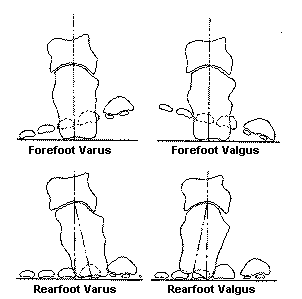The Gait Guys

Rearfoot varus
http://www.thebarefootrunners.org/index.php?posts/150367
Forefoot valgus
In a nutshell, there are 5 basic foot types; two involving challenges to the forefoot, and two challenging the rear foot. These can be rigid and non adapting, flexible and adapting, or somewhere in between. The fifth type is the ideal of what we all hope to have.

Rearfoot varus
Rearfoot valgus... excessive use of the peroneal muscle group to fight this supinated tendency and prevent ankle sprains. The 4th and 5th metatarsals typically take on more stress, and are often painful. Loading the lateral aspect of the limb shifts the center of gravity and challenges stability in the frontal plane, often leading to hip problems, such as trochanteric bursitits and IT band friction type syndromes and knee/patellar tracking issues.
Forefoot varus... excessive internal rotation strain on the lower kinetic chain, often with collapse of the knees inward (genu valgum or “knock knees”). Due to the midfoot collapse, the deep calf muscles are typically overused and strained leading to medial ankle region tendonopathies, as they attempt to slow the rate of pronation and arch collapse. ...
Because the lower limb is internally rotated so much, the external rotators are over burdened leading to fatigue and weakness of the glutes and shortening of the TFL, leading to the chronic IT Band syndromes. Low back pain is common because of forward tip of the pelvis.
Pathomechanics of the Footdrags the knee medially and leads to the same hip and pelvic stability and external rotation challenges we discussed in the rearfoot valgus, as well as patellofemoral tracking syndromes
PDF: Pathomechanics of Structural Foot Deformitiesthe most clinically common pathomechanical abnormality.
Thread with more information on Forefoot varus from The Gait GuysA forefoot varus is a very destructive deformity and is encountered frequently in patients with lower extremity dysfunction
http://www.thebarefootrunners.org/index.php?posts/150367
Forefoot valgus
NormalLack of optimal toe off means poor propulsion strategies from the calf and gluteals. Consequently, patellar tracking is challenged, the limb is in a more relative external rotation, and the peroneal muscles are typically overburdened in an attempt to stabilize the lateral ankle area.
PDF: The Five Most Common Pathomechanical Foot Typeshas appropriate shock absorption through normal pronation and it has nice rigidity at toe off from normal supination. This foot enjoys all of the perks of full joint motion ranges and nice skill, endurance and strength. It adequately controls the normal amounts of internal and external limb spin, and affords the ability to stabilize the pelvis in a strong neutral position
PDF: Clinically Significant Foot TypesRearfoot varus, forefoot varus, equinus, plantarflexed first ray, forefoot valgus













